
Introducing the Yuneec E430
An Electric Airplane
With over 27,000 hours, and having tested new planes since
1984, it’s fairly rare that something completely new comes along,
but this summer I became an electric pilot.
As a test pilot, my business usually picks up after Sun N Fun, for
clients trying to get planes ready for Oshkosh. Usually these folks
are a little optimistic of their true chances of making the show, and
to be honest I'm getting a little jaded as well. So in May, when I get
a call from Tian Yu from China asking about testing a new plane to
debut at Oshkosh, I think ‘Yeah, right, situation normal’.
This call had many obstacles. First, I was at a soaring contest and
like most contests it was remote. My cell phone worked when I
stood behind my camper facing south and holding still. The caller
was speaking English as a 4th language and when I found they
hadn’t started building the plane yet, I pretty much dismissed them
as a serious client for this year.
As luck would have it, I get his next call in the race pit at Laguna
Seca with many loud racecars and a cell phone that works if I
stand next to the porta-potty facing west. I understand they had to
change the design, as FAA didn’t think they would ever allow a
twin-motored LSA (light sport aircraft). They still think they can
make Oshkosh in three months. Again, I pretty much answer all his
questions but don’t think there is a chance of Oshkosh, 09.
Imagine my surprise when two months later I get the call (at
another glider meet where the cell works facing north on hill)
asking if I can be in Shanghai next Wednesday to test fly the new
E430. Scheduling didn’t permit that but after two flights in
Shanghai, the plane would be shipped to me in Camarillo, CA for a
US test program then, if all went well, on to Oshkosh.
When the plane arrived, I spent most of the first day inspecting the
construction and recommending changes. This was a unique
experience as only Tian spoke English and Chinese. Any changes
I suggested were pantomimed to Mr. Lee (the project leader) with
translation from Tian. I think the one Chinese phrase that could
have helped would have been ‘This is okay for a model but the
standards are different for aircraft that carry people’.
The company that created this machine is the largest manufacture
of ready to fly, radio-controlled airplanes in the world. Not
surprising then, that this was built as a large model. They actually
built a full size RC plane ballasted with sand bags before this
plane. I get to work with all kinds of experience levels in my
business but these guys were really great. Nobody told them they
couldn’t build an airplane in three months, so they just did it. It’s
refreshing to work with a team with no limits. They’re relentless.
They’re ingenious. And they are determined to make electric flight
a reality.
For example, I’d find a rod end without a large area washer and
the pantomime would begin. At some point, Mr. Lee would get what
I meant and why. Then, after five minutes of rapid speaking to his
crew and an hour later, every rod and would be up to spec.
Another example is the canopy latch. Because I was wearing a
parachute, I was sitting forward of the normal seating position. The
canopy latch hit me in the leg when it was closed.
I demonstrate the problem then try to offer solutions based on
local supplies and tools available. I’ve got all kind of alternate
methods, most of which could be done in a few hours. The team
huddles around the cockpit for a few minutes then moves away. A
little while later Mr. Lee motions me to look at his handiwork. The
latch that has no visible way to be disassembled, it is in the same
place but a mirror image of itself. Now when the latch is closed, it
folds into itself and is out of the way. I’ve had 20 hours in this
plane and every time I open or close the latch, I wonder how they
did that. The latch is bonded in and can’t be disassembled. Maybe
I’ll have to learn Mandarin to find out how they did it.
Most electric aircraft projects seem to be plagued with problems of
making the whole system work. A particular motor doesn’t work
well with another controller or battery system. The Yuneec method
was very different and very simple. Make everything in-house to
your specs and your design. The batteries, motor controller and
even the balancing battery charger are all designed and built at
Yuneec. And magically, they all work seamlessly together.
After two days of assembly, we called the FSDO for our
airworthiness certificate. That’s when we found out that the two
FAA inspectors who were championing the project, had been
relocated to another big project. The FSDO had no idea what we
were talking about. An electric plane? Really? After a nice
meeting, they gave us a list of DARs. We found one willing to take
on the project, although with the supervision from the local FSDO,
MIDO and Washington DC, it was like working with big brother
watching. There big concern was flying with batteries and thermal
runaway protection. To the FAA's credit, each individual who came
and saw the plane and was briefed and educated on the batteries
and systems, left with a new understanding and even support for
electric flight.
Finally the part I was looking forward to, my first electric flight. I did
a few runway hops then went up to 3,000 feet over Camarillo. The
plane flew much like a sailplane, which if you look at the sculpted
wing is not surprising. The E430 has very docile handling
characteristics and great visibility along with a very quiet ride and
hardly any vibration. I was a little disappointed in the first flight as
after 40 minutes I was running out of batteries.
This brings up two areas that I, and anyone flying electric, need to
understand. First, Tian gently convinced me I was flying too fast.
He had calculated that I should only need 7 KW’s (kilowatts) to
maintain level flight. I was using almost twice that amount. A few
more flights and comparing airspeed to GPS ground speed, along
with installing a new static system (which models don't need) and I
was able to fly level flight at 7.5 KW. This, and learning how to
manage my KW's, led to many flights over 1.5 hours with reserves.
The second area unique to electric flight is how long can I fly? Or,
is there any one gauge that tells me what I have left? The answer
is yes and no. Before flight if the voltage is 150 you know the
batteries are fully charged and you have about 20 KW avail. As
soon as you start to load the batteries, the voltage goes down and
in proportion to the load. I take off at 40 KW and by 200 feet, the
voltage is 146, but then I make my first power reduction to 25 KW
and the voltage goes back up to 148. I played with several climb
profiles trying to find the most efficient way to gain altitude.
In this respect it’s very much like driving my Prius, I’m always
looking at the MPG to drive in the most efficient manner. By using
some soaring skills and being more in tune with the atmosphere
around you every flight can be an adventure to become more
efficient.
I fly a DG400, self-launching sailplane. In this plane, you must
feather the prop and store the engine to glide. In the E430 when
you select Zero throttle, the motor, having electric braking, stops
the prop. When you move the throttle forward, Voila! Instant
power, no unfeathering or engine extension needed. Once you get
used to this, every time you descend, you just stop the prop and
glide, saving those precious KW’s in the battery. When landing, if
you are a little high, set 400 rpm and use the prop as an air brake.
Now the big question, ‘Is electric power practical?’ Again, yes and
no. If your mission is flights at or under two hours, then yes, the
E430 provides trouble free access to the skies and is a great
training platform. Also, it makes a great touring, self launch
sailplane. Now, if your mission is a 400-mile cross-country, then
probably the E430 is not the plane for you. The time to recharge
the batteries pretty much prevents long, single day, cross-
countries (at this point). It will be interesting with the addition of
solar cells to extend the range and better batteries, how long it will
be until the 400-mile electric flight is a reality. I bet Mr. Lee doesn't
think it will be long.
Where I think the E430 will really stand out is in a training role.
Keep an extra set of batteries and charge them while the current
flight is up. When we had our flight school, the engine
maintenance, oil changes and fouled plugs, just about killed any
chance we had to make money. The E430 with about $3.00 an
hour fuel (electric charge) and no engine maintenance should be
a dream to a flight school. Also, it looks and flies gracefully and
after every electric flight it’s hard not to smile. And while it still hits
bugs, there is no oil on the hard-to-reach belly. I think electric
flight is here to stay.
Dave Morss, electric pilot
An Electric Airplane
With over 27,000 hours, and having tested new planes since
1984, it’s fairly rare that something completely new comes along,
but this summer I became an electric pilot.
As a test pilot, my business usually picks up after Sun N Fun, for
clients trying to get planes ready for Oshkosh. Usually these folks
are a little optimistic of their true chances of making the show, and
to be honest I'm getting a little jaded as well. So in May, when I get
a call from Tian Yu from China asking about testing a new plane to
debut at Oshkosh, I think ‘Yeah, right, situation normal’.
This call had many obstacles. First, I was at a soaring contest and
like most contests it was remote. My cell phone worked when I
stood behind my camper facing south and holding still. The caller
was speaking English as a 4th language and when I found they
hadn’t started building the plane yet, I pretty much dismissed them
as a serious client for this year.
As luck would have it, I get his next call in the race pit at Laguna
Seca with many loud racecars and a cell phone that works if I
stand next to the porta-potty facing west. I understand they had to
change the design, as FAA didn’t think they would ever allow a
twin-motored LSA (light sport aircraft). They still think they can
make Oshkosh in three months. Again, I pretty much answer all his
questions but don’t think there is a chance of Oshkosh, 09.
Imagine my surprise when two months later I get the call (at
another glider meet where the cell works facing north on hill)
asking if I can be in Shanghai next Wednesday to test fly the new
E430. Scheduling didn’t permit that but after two flights in
Shanghai, the plane would be shipped to me in Camarillo, CA for a
US test program then, if all went well, on to Oshkosh.
When the plane arrived, I spent most of the first day inspecting the
construction and recommending changes. This was a unique
experience as only Tian spoke English and Chinese. Any changes
I suggested were pantomimed to Mr. Lee (the project leader) with
translation from Tian. I think the one Chinese phrase that could
have helped would have been ‘This is okay for a model but the
standards are different for aircraft that carry people’.
The company that created this machine is the largest manufacture
of ready to fly, radio-controlled airplanes in the world. Not
surprising then, that this was built as a large model. They actually
built a full size RC plane ballasted with sand bags before this
plane. I get to work with all kinds of experience levels in my
business but these guys were really great. Nobody told them they
couldn’t build an airplane in three months, so they just did it. It’s
refreshing to work with a team with no limits. They’re relentless.
They’re ingenious. And they are determined to make electric flight
a reality.
For example, I’d find a rod end without a large area washer and
the pantomime would begin. At some point, Mr. Lee would get what
I meant and why. Then, after five minutes of rapid speaking to his
crew and an hour later, every rod and would be up to spec.
Another example is the canopy latch. Because I was wearing a
parachute, I was sitting forward of the normal seating position. The
canopy latch hit me in the leg when it was closed.
I demonstrate the problem then try to offer solutions based on
local supplies and tools available. I’ve got all kind of alternate
methods, most of which could be done in a few hours. The team
huddles around the cockpit for a few minutes then moves away. A
little while later Mr. Lee motions me to look at his handiwork. The
latch that has no visible way to be disassembled, it is in the same
place but a mirror image of itself. Now when the latch is closed, it
folds into itself and is out of the way. I’ve had 20 hours in this
plane and every time I open or close the latch, I wonder how they
did that. The latch is bonded in and can’t be disassembled. Maybe
I’ll have to learn Mandarin to find out how they did it.
Most electric aircraft projects seem to be plagued with problems of
making the whole system work. A particular motor doesn’t work
well with another controller or battery system. The Yuneec method
was very different and very simple. Make everything in-house to
your specs and your design. The batteries, motor controller and
even the balancing battery charger are all designed and built at
Yuneec. And magically, they all work seamlessly together.
After two days of assembly, we called the FSDO for our
airworthiness certificate. That’s when we found out that the two
FAA inspectors who were championing the project, had been
relocated to another big project. The FSDO had no idea what we
were talking about. An electric plane? Really? After a nice
meeting, they gave us a list of DARs. We found one willing to take
on the project, although with the supervision from the local FSDO,
MIDO and Washington DC, it was like working with big brother
watching. There big concern was flying with batteries and thermal
runaway protection. To the FAA's credit, each individual who came
and saw the plane and was briefed and educated on the batteries
and systems, left with a new understanding and even support for
electric flight.
Finally the part I was looking forward to, my first electric flight. I did
a few runway hops then went up to 3,000 feet over Camarillo. The
plane flew much like a sailplane, which if you look at the sculpted
wing is not surprising. The E430 has very docile handling
characteristics and great visibility along with a very quiet ride and
hardly any vibration. I was a little disappointed in the first flight as
after 40 minutes I was running out of batteries.
This brings up two areas that I, and anyone flying electric, need to
understand. First, Tian gently convinced me I was flying too fast.
He had calculated that I should only need 7 KW’s (kilowatts) to
maintain level flight. I was using almost twice that amount. A few
more flights and comparing airspeed to GPS ground speed, along
with installing a new static system (which models don't need) and I
was able to fly level flight at 7.5 KW. This, and learning how to
manage my KW's, led to many flights over 1.5 hours with reserves.
The second area unique to electric flight is how long can I fly? Or,
is there any one gauge that tells me what I have left? The answer
is yes and no. Before flight if the voltage is 150 you know the
batteries are fully charged and you have about 20 KW avail. As
soon as you start to load the batteries, the voltage goes down and
in proportion to the load. I take off at 40 KW and by 200 feet, the
voltage is 146, but then I make my first power reduction to 25 KW
and the voltage goes back up to 148. I played with several climb
profiles trying to find the most efficient way to gain altitude.
In this respect it’s very much like driving my Prius, I’m always
looking at the MPG to drive in the most efficient manner. By using
some soaring skills and being more in tune with the atmosphere
around you every flight can be an adventure to become more
efficient.
I fly a DG400, self-launching sailplane. In this plane, you must
feather the prop and store the engine to glide. In the E430 when
you select Zero throttle, the motor, having electric braking, stops
the prop. When you move the throttle forward, Voila! Instant
power, no unfeathering or engine extension needed. Once you get
used to this, every time you descend, you just stop the prop and
glide, saving those precious KW’s in the battery. When landing, if
you are a little high, set 400 rpm and use the prop as an air brake.
Now the big question, ‘Is electric power practical?’ Again, yes and
no. If your mission is flights at or under two hours, then yes, the
E430 provides trouble free access to the skies and is a great
training platform. Also, it makes a great touring, self launch
sailplane. Now, if your mission is a 400-mile cross-country, then
probably the E430 is not the plane for you. The time to recharge
the batteries pretty much prevents long, single day, cross-
countries (at this point). It will be interesting with the addition of
solar cells to extend the range and better batteries, how long it will
be until the 400-mile electric flight is a reality. I bet Mr. Lee doesn't
think it will be long.
Where I think the E430 will really stand out is in a training role.
Keep an extra set of batteries and charge them while the current
flight is up. When we had our flight school, the engine
maintenance, oil changes and fouled plugs, just about killed any
chance we had to make money. The E430 with about $3.00 an
hour fuel (electric charge) and no engine maintenance should be
a dream to a flight school. Also, it looks and flies gracefully and
after every electric flight it’s hard not to smile. And while it still hits
bugs, there is no oil on the hard-to-reach belly. I think electric
flight is here to stay.
Dave Morss, electric pilot
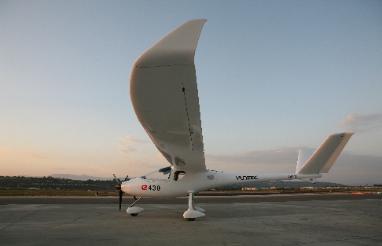

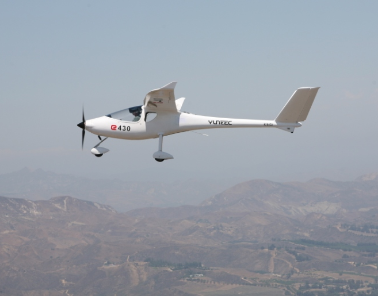
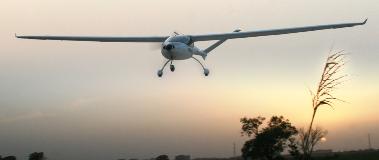
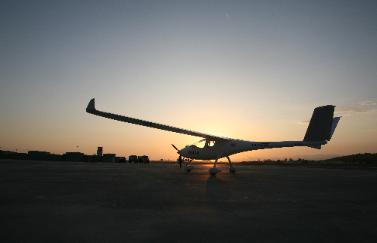

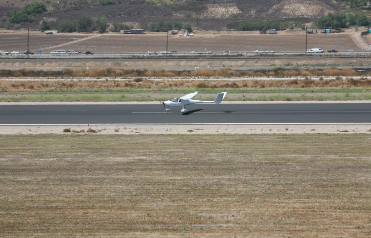
| Work |
